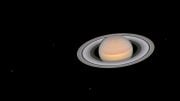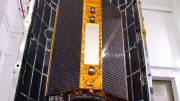Hurricane Ida off the Louisiana coast as a Category 4 hurricane on the morning of Sunday, August 29th at 10:13am (CDT) right before making landfall. Credit: NASA’s Scientific Visualization Studio
Hurricane Ida struck southeast Louisiana as a powerful Category 4 storm on Sunday, August 29, 2021- the 16th anniversary of Hurricane Katrina’s landfall in 2005. Ida brought destructive storm surge, high winds, and heavy rainfall to the region, and left over 1 million homes and businesses without power, including the entire city of New Orleans.
The NASA / JAXA GPM Core Observatory satellite flew over the eye of Ida shortly before landfall at 10:13 a.m. CDT (1513 UTC), capturing data on the structure and intensity of precipitation within the storm. This animation shows NASA’s IMERG multi-satellite precipitation estimates and NOAA GOES-E satellite cloud data, followed by 3D data from the GPM Core satellite. NASA processed these observations in near real-time and made them available to a wide range of users including weather agencies and researchers.
After Ida passed over Cuba as a Category 1 storm, it intensified rapidly to reach Category 4 strength near its Louisiana landfall. According to the National Hurricane Center (NHC), Ida’s central pressure reached a minimum of 929 hPa with a 15 nautical mile (17 statute mile) wide eye. At the time, Ida had its lifetime-maximum wind speed of 130 kt (150 mph) in the eyewall shortly before 10 a.m. CDT on August 29.
The 3D Dual-frequency Precipitation Radar (DPR) data collected by the GPM Core satellite shows a healthy hurricane inner core in Ida. The small 17-mile-diameter (27-kilometer-diameter) eyewall is surrounded by a nearly complete outer ring of precipitation approximately 85 miles (140 kilometers) in diameter. Beyond this central structure, an arc of precipitation exists another 40 miles (64 kilometers) further from the eye to the southeast. The eye hosts many clouds extending well above 6 miles (10 km), which indicates that Ida was still actively growing at the time of this overpass.
NASA continues to monitor Ida as it moves north over the southeastern U.S., providing Earth-observing satellite data, maps and analysis to stakeholders to aid response and recovery efforts.









Be the first to comment on "Dramatic NASA Satellite Video Examines Hurricane Ida’s Eye in 3D"